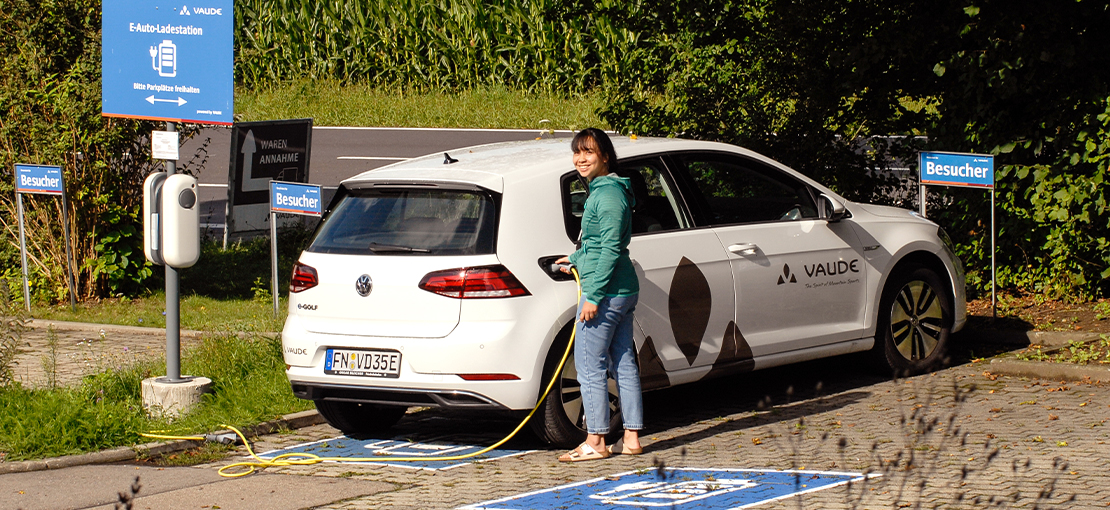
VAUDE focuses on E-Mobility
Curbing climate change
We are at a turning point in time: Climate change is one of the central challenges facing humanity. Stopping global warming is an obligation for us all. VAUDE is taking responsibility and moving forward. In order to protect the environment, we consistently aim for climate neutrality in all of our business segments
Employee mobility at VAUDE is already climate neutral
Since 2011, we have been recording all emissions originating from business travel, our vehicle fleet and commuting, and we pay a carbon offset to the myclimate project. More about this here
We therefore know that employee mobility is one of the largest items in our climate balance sheet every year. We have a great need for action on this issue in order to keep reducing emissions from employee mobility, for example by switching to electric vehicles.
Specifically, our goal is to reduce emissions from employee mobility 25 % by 2024 compared with 2019.
Vehicle fleet becomes E-mobile
This is why we are gradually converting our fleet to electric vehicles. At our company headquarters, these vehicles are charged with 100% green electricity during working hours. More about the power supply at VAUDE here.
In addition, electric cars don’t emit CO2, pollution or particulate matter while driving, unlike vehicles with combustion engines. Nevertheless, the sustainability of electric vehicles always depends on the source of the electricity that you use to charge them. They’re only more eco-friendly when you use electricity from renewable sources! Of course, this also applies to hybrid vehicles. Background information and figures can be found here on the website of the German Federal Ministry for the Environment.
At the same time, we are pursuing the following goals in the restructuring of our company fleet:
- Reduction of number of vehicles
- Reduction in the number of kilometers driven
- Driver training for greater safety and lower fuel consumption
The future belongs to hydrogen
In this overall context, we are also following the developments on hydrogen with the greatest interest. We see e-mobility as a "bridge technology". If there are major leaps in the development of green hydrogen technology that make the use of hydrogen vehicles appear feasible and financially reasonable, we are open to the prospect of taking this path. So far this has not (yet) been the case, not in any aspect - neither in terms of vehicle availability, charging infrastructure, energy consumption nor in terms of support measures.
Transitional period with diesel
It will take some time until we have converted the entire fleet to electric vehicles. We will continue to use our existing diesel vehicles until the end of the leasing period. Economical driving is therefore important.
|
|
Basis Year GRI 2013 |
Basis Year Mobility Goals 2015 |
Previous Year 2019 |
Current Year 2020 |
|||||
|---|---|---|---|---|---|---|---|---|---|
|
|
|
|
absolute |
to 2013 |
to 2015 |
absolute |
to 2013 |
to 2015 |
to 2019 |
|
Number of company vehicles (yearly average) [pc] |
65 |
75 |
60 |
-8% |
-20% |
60 |
0 |
-13% |
8% |
|
Total kilometers driven by company vehicles |
2,368,262 |
2,330,397 |
1,930,104 |
-19% |
-17% |
1,930,104 |
-40% |
-39% |
-24% |
|
fuel consumption [liters] |
170,955 |
173,061 |
129,698 |
-24% |
-25% |
129,698 |
-57% |
-57% |
-43% |
|
Average consumption per vehicle per 100 km |
7,22 |
7,43 |
6,72 |
-7% |
-10% |
6,72 |
-29% |
-31% |
-25% |
Fuel consumption VAUDE
Create your own infographicsThe Corona pandemic has also been noticeable in the fuel consumption of the VAUDE company fleet. Fewer business trips and, above all, significantly fewer kilometers driven privately with company cars has led to the lower consumption shown in the graph.
New system for privately used company cars
Here’s an example: Some employees use their large company VW van (that is authorized for private use) not just once or twice a year for family holidays, but also for the daily commute to work. This is an expensive indulgence for the employees because they have to pay tax on the monetary value, and also for VAUDE because a large car is more expensive and creates more emissions, leading to costly climate compensation fees.
Wouldn’t it make more sense to switch to a smaller (electric) car? And wouldn’t making a van available for their holidays, plus a rail card, be a good way for VAUDE to compensate them?
This is the kind of scheme we want to develop for attractive alternatives to the (large) company car. However, this is really a hard nut to crack. The preferential tax treatment of company cars via the company car lump sum ("1% regulation") and complicated regulations for the taxation of benefits in kind make virtually all alternatives much less attractive financially. It’s no wonder that a majority of the annual new registrations of passenger cars are for company cars.
Fuels in the supply chain
All facts and figures given here refer to the VAUDE company headquarters at Tettnang-Obereisenbach. With no data, we are unable at present any concrete figures for fuel consumption for our upstream supply chain.
It is clear, however, that transport and the resulting strain it places on the health of people and the environment creates global problems (for example, smog in Beijing). We are all facing the same challenges in the transportation of goods and people. Read more about our merchandise logistics.
| GRI: | 302-1 |
| GRI: | 302-2 |
| GRI: | 302-3 |
| GRI: | 302-4 |




